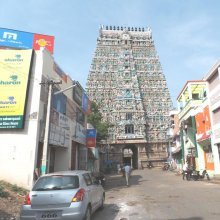Nammalvar, Nammāḻvār, Nammālvār: 5 definitions
Introduction:
Nammalvar means something in Hinduism, Sanskrit, the history of ancient India, Tamil. If you want to know the exact meaning, history, etymology or English translation of this term then check out the descriptions on this page. Add your comment or reference to a book if you want to contribute to this summary article.
Images (photo gallery)
In Hinduism
Purana and Itihasa (epic history)
Source: archive.org: Puranic EncyclopediaNammālvār (नम्माल्वार्).—The first of the twelve great Ālvārs. The Śaivite devotees of South India are called Nāyanārs and the Vaisṇavite devotees, Ālvārs. The word ālvār means, a devotee of God. The Vaiṣṇava religion says that the twelve ālvārs are the incarnations of Ādiśeṣa and Garuḍa the followers and the embodied deities of the Conch and the discus the weapons of Viṣṇu. It is mentioned in Śrīmad Bhāgavata that divine persons who are followers of Viṣṇu will incarnate on the earth in Kaliyuga and that their native places will be the banks of the holy rivers in Drāviḍa such as Tāmraparṇī, Kṛtamālā (Vaigai), Payasvinī (Pāpanāśinī) and Kāverī. It is stated about these divine persons in Viṣṇumāhātmya that they would take birth in any caste and compose Drāviḍa songs and thereby propagate lofty truths. The collection of Drāviḍa songs thus composed by the ālvārs is called 'Divya Prabandha' (Divine Composition).
There are four thousand songs in four parts in the Divine composition and hence it has the name Nālāyira Prabandham 'Four thousand composition'. The theme of the 1st and 2nd thousands is a secret known as 'Tirumantra' (the divine spell). The third thousand is concerned with the "Caramaśloka" (the verse of death) and in the fourth "Dvayamantra" is dealt with. The Tirumantra (the divine spell) is the collection of of three words Om, namaḥ and Nārāyaṇāya. (See full article at Story of Nammālvār from the Puranic encyclopaedia by Vettam Mani)

The Purana (पुराण, purāṇas) refers to Sanskrit literature preserving ancient India’s vast cultural history, including historical legends, religious ceremonies, various arts and sciences. The eighteen mahapuranas total over 400,000 shlokas (metrical couplets) and date to at least several centuries BCE.
Vaishnavism (Vaishava dharma)
Source: Brill: Śaivism and the Tantric Traditions (vaishnavism)Nammāḻvār refers to one of the Teachers mentioned in the guruparaṃparā of Vedānta Deśika’s Yatirājasaptati.—The poem’s first ten verses create the context for the exaltation of Rāmānuja. This context is the lineage of teachers (guruparaṃparā) who preceded him and are listed in the first eight verses of the poem in the following order: Nārāyaṇa, Śrī-Lakṣmī, Viṣvaksena, Nammāḻvār, Puṇḍarīkākṣa (Uyyaṅkoṇṭār), Śrīrāmamiśra (Maṇakkāl Nampi), Yāmuna (Āḷavantār) and Mahāpūrṇa (Periya Nampi). In verse 11 Rāmānuja is addressed, for the first time, with the phrase “Lord of the Ascetics” (patiṃ yatīnām).
Source: academia.edu: Dvādaśa-mūrti in Tamil TraditionNammāḻvār (நம்மாழ்வார்) (shortly Nam “our”) in Tamil Vaiṣṇava tradition comes next to Tirumaṅkkai in as far as the contribution to Indian sacred literature is concerned. His works consist of the following hymnal compositions: Tiruvāciriyam (7 hymns), Tiruviruttam (100 hymns), Periya-tiruvantāti (87 hymns) and Tiruvāymoḻi (1,102 hymns). Zvelebil (1974: 107) assigns Nammāḻvār to the later half of the ninth and early tenth century, exactly 880-930 CE. [...] Nammāḻvār was known as Māṟan, Caṭakōpaṉ, Caṭāri and Tiruppuḷiyāḻvār. He was by birth a veḷḷāḷa (landlord or serf). He is considered a manifestation of Viṣvaksena, Tamil Cēṉai-mutaliyār. His disciple was Maturakavi, a Brāhmaṇa.

Vaishnava (वैष्णव, vaiṣṇava) or vaishnavism (vaiṣṇavism) represents a tradition of Hinduism worshipping Vishnu as the supreme Lord. Similar to the Shaktism and Shaivism traditions, Vaishnavism also developed as an individual movement, famous for its exposition of the dashavatara (‘ten avatars of Vishnu’).
India history and geography
Source: academic.ru: South Asian ArtsThe last of the Āḻvārs, Nammāḻvār, writing in the 9th century, expresses poignantly both the pain and ecstasy of being in love with God, revivifying mythology into revelation.

The history of India traces the identification of countries, villages, towns and other regions of India, as well as mythology, zoology, royal dynasties, rulers, tribes, local festivities and traditions and regional languages. Ancient India enjoyed religious freedom and encourages the path of Dharma, a concept common to Buddhism, Hinduism, and Jainism.
Languages of India and abroad
Tamil dictionary
Source: DDSA: University of Madras: Tamil LexiconNammāḻvār (நம்மாழ்வார்) [nam-āḻvār] noun < idem. +. A Vaiṣṇava saint, author of Tiruvāymoḻi and other works, foremost of ten āḻvār, q.v.; ஆழ் வார்கள் பதின்மருள் தலைமையானவரும் திருவாய்மொழி முதலிய பிரபந்தங்களின் ஆசிரியருமான திருமாலடியார். [azh varkal pathinmarul thalaimaiyanavarum thiruvaymozhi muthaliya pirapanthangalin asiriyarumana thirumaladiyar.] (உபதேசாத்தினமாலை [upathesathinamalai] 50.)
Tamil is an ancient language of India from the Dravidian family spoken by roughly 250 million people mainly in southern India and Sri Lanka.
See also (Relevant definitions)
Full-text (+33): Catakopan, Tiruvaymoli, Periya-tiruvantati, Naviran, Tiruvaciriyam, Kurukur, Nalayiraprabandham, Maturakavi, Parankucan, Tiruviruttam, Catari, Tiruppuliyalvar, Namperumal, Vakulapushanar, Pulinkuti, Varakunamankai, Maran, Civaramankai, Catakoparantati, Alvartirunakari.
Relevant text
Search found 8 books and stories containing Nammalvar, Nammāḻvār, Nammālvār, Nammazhvar, Nammaazhvaar, Nam-āḻvār, Nam-alvar; (plurals include: Nammalvars, Nammāḻvārs, Nammālvārs, Nammazhvars, Nammaazhvaars, āḻvārs, alvars). You can also click to the full overview containing English textual excerpts. Below are direct links for the most relevant articles:
Tiruvaymoli (Thiruvaimozhi): English translation (by S. Satyamurthi Ayyangar)
Appendix: The ‘Uhhaya Vedanta’ concept in Sri Vaishnavism
Pasuram 5.5.1 < [Section 5 - Fifth Tiruvaymoli (Ennaneyo, annaimirkal)]
The Mysticism of Nammalvar < [March 1945]
Sri Ramanuja and Divya Prabandham < [October – December, 1995]
’Tis He < [November, 1928]
Puranic encyclopaedia (by Vettam Mani)
The Religion and Philosophy of Tevaram (Thevaram) (by M. A. Dorai Rangaswamy)
Introduction < [Volume 4.2.3 - Philosophy of God]
Nayanar 49: Kari < [Volume 4.1.1 - A comparative study of the Shaivite saints the Thiruthondathogai]
Nayanar 24: Karaikkal Ammeiyar (Ammaiyar) < [Volume 4.1.1 - A comparative study of the Shaivite saints the Thiruthondathogai]
Later Chola Temples (by S. R. Balasubrahmanyam)
Temples in Kumbakonam < [Chapter IV - Temples of Vikrama Chola’s Time]
Temples in Ponnamaravati < [Chapter VIII - Temples of Rajaraja II’s Time]
Temples in Tirukkannapuram < [Chapter II - Temples of Kulottunga I’s Time]
Parama Samhita (English translation) (by Krishnaswami Aiyangar)
The Pāñcarātra and the Tamil Ālvārs < [Introduction]
Related products

